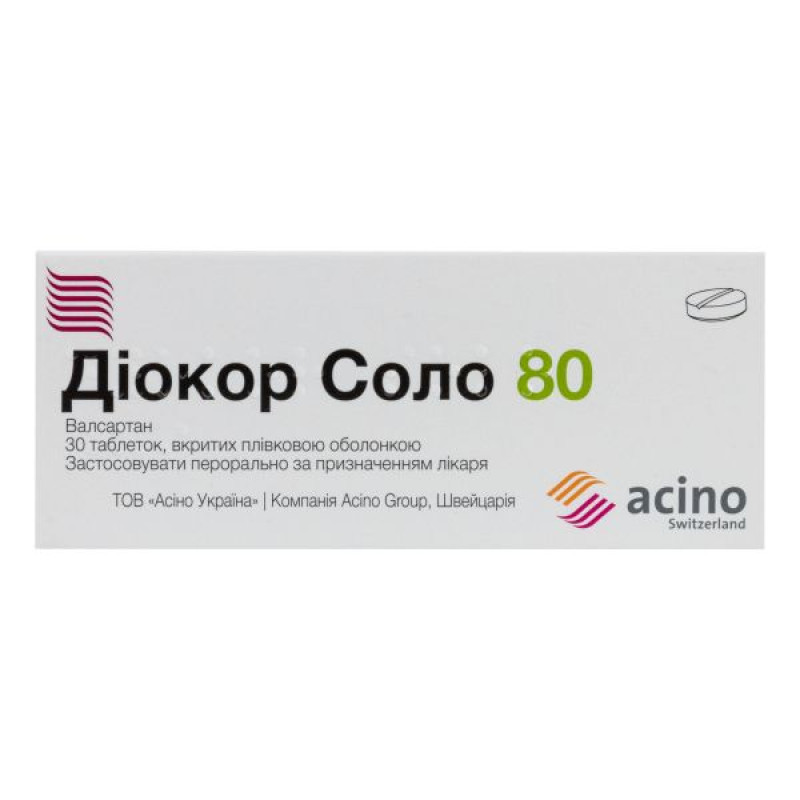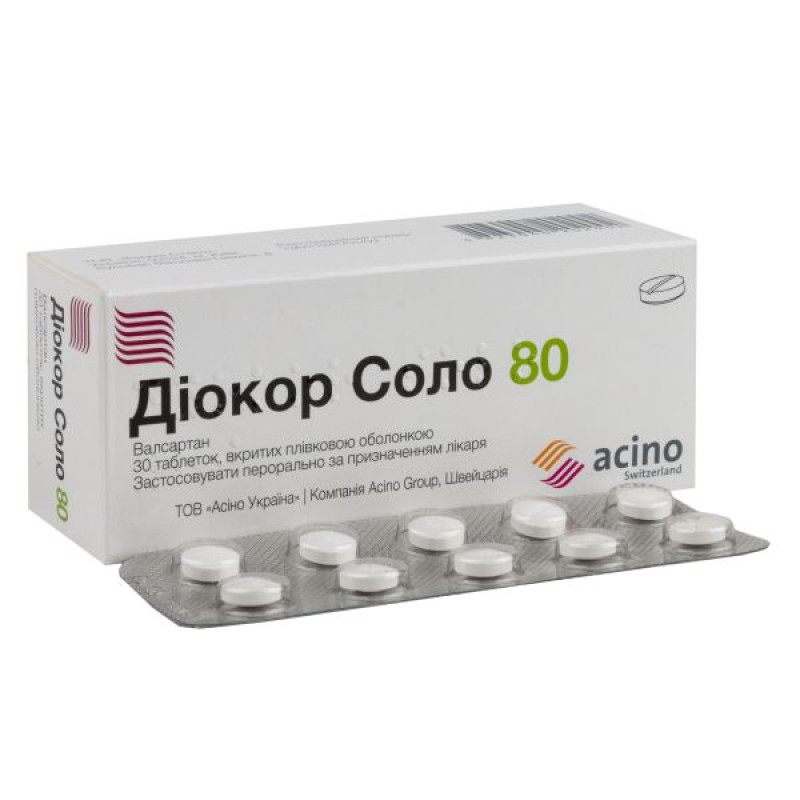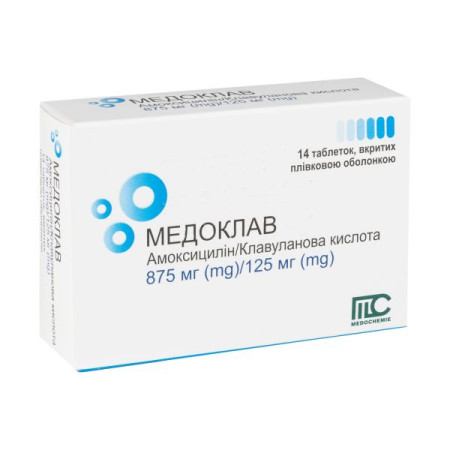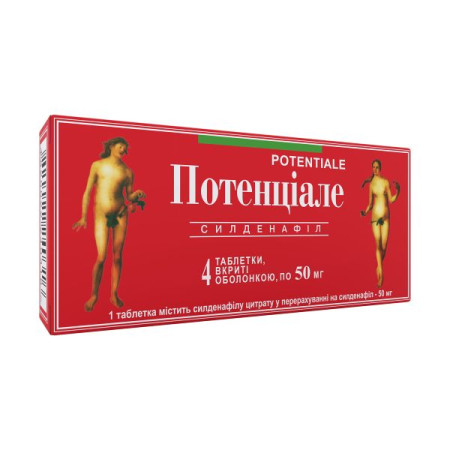Diocor Solo 80 film-coated tablets 80 mg blister No. 30
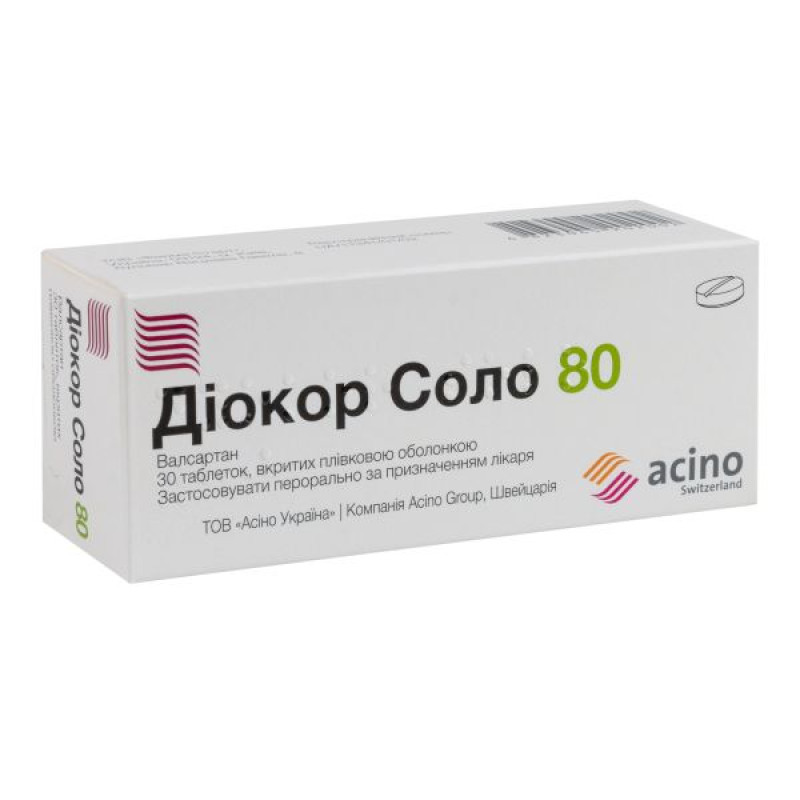
Instructions Diocor Solo 80 film-coated tablets 80 mg blister No. 30
Composition
active ingredient: valsartan;
1 film-coated tablet contains 80 mg or 160 mg of valsartan;
excipients: calcium hydrogen phosphate dihydrate, microcrystalline cellulose, hydroxypropyl cellulose, croscarmellose sodium, colloidal anhydrous silicon dioxide, talc, magnesium stearate, coating for applying the shell Opadry II White (polyethylene glycol, polyvinyl alcohol, talc, titanium dioxide (E 171)).
Dosage form
Film-coated tablets.
Main physicochemical properties:
Diocor Solo 80 – round tablets with a biconvex surface, coated with a white film coating, with a score;
Diocor Solo 160 are round tablets with a biconvex surface, coated with a white film coating.
Pharmacotherapeutic group
Simple angiotensin II antagonist drugs.
ATX code C09C A03.
Pharmacological properties
Pharmacodynamics
Valsartan is an active, specific angiotensin II receptor antagonist for oral administration. It acts selectively on the AT1 receptor subtype, responsible for the known effects of angiotensin II. Increased plasma levels of angiotensin II after blockade of AT1 receptors with valsartan may stimulate the unblocked AT2 receptor, which counteracts the effect of the AT1 receptor. Valsartan does not exhibit any partial agonist activity at the AT1 receptor, but has a much higher (approximately 20,000-fold) affinity for the AT1 receptor than for the AT2 receptor. Valsartan does not inhibit ACE (angiotensin-converting enzyme), also known as kininase II, which converts angiotensin I to angiotensin II and destroys bradykinin. The use of the drug in patients with arterial hypertension leads to a decrease in blood pressure without affecting the pulse rate. The onset of the hypotensive effect is noted within 2 hours, the maximum - within 4-6 hours after oral administration; the duration of action is more than 24 hours. The maximum therapeutic effect develops 4 weeks after the start of treatment and is maintained with long-term therapy. When used with hydrochlorothiazide, a significant additional decrease in blood pressure is achieved. Abrupt withdrawal of the drug is not accompanied by the development of withdrawal syndrome. With long-term use of the drug in patients with arterial hypertension, it was found that the drug had no significant effect on the level of total cholesterol, uric acid, and in fasting studies - on the concentration of triglycerides and glucose in blood serum. The use of the drug leads to a decrease in hospitalizations for heart failure, a slowdown in the progression of heart failure, an improvement in the functional class according to the NYHA classification, an increase in the ejection fraction, as well as a decrease in heart failure symptoms and an improvement in the quality of life compared to placebo.
It is known that the VALIANT study demonstrated the effectiveness of valsartan, as well as captopril, in reducing overall mortality after myocardial infarction. Valsartan was also effective in reducing mortality from cardiovascular pathology and hospitalizations due to heart failure, as well as recurrent myocardial infarction. Valsartan positively affected such an indicator as the period of time after an acute myocardial infarction to the appearance of the first manifestations of cardiovascular pathology leading to death.
Children: The antihypertensive effect of valsartan has been evaluated in 4 randomized, double-blind clinical trials in 561 children aged 6 to 18 years and in 165 children aged 1 to 6 years. Renal and urinary disorders and obesity were the most common underlying medical conditions causing hypertension in children included in these trials.
Clinical experience in children aged 6 years and older. In a clinical study involving 261 hypertensive children aged 6 to 16 years, patients weighing < 35 kg received 10, 40 or 80 mg of valsartan per day (low, medium and high doses), and patients weighing ≥ 35 kg received 20, 80 and 160 mg of valsartan per day (low, medium and high doses). At the end of 2 weeks, valsartan reduced systolic and diastolic blood pressure in a dose-dependent manner. Overall, the three valsartan dose levels (low, medium and high) significantly reduced systolic blood pressure by 8, 10, 12 mmHg from baseline, respectively.
Clinical experience in children under 6 years of age
Valsartan is not recommended for use in this age group.
Absorption. After oral administration of valsartan, peak plasma concentrations (Cmax) are reached within 2–4 hours, and after 1–2 hours for the solution. The mean absolute bioavailability of the tablets and solution is 23% and 39%, respectively. Food reduces the exposure (as determined by AUC) of valsartan by approximately 40% and the maximum plasma concentration (Cmax) by approximately 50%, although plasma concentrations of valsartan starting from approximately 8 hours after dosing are similar in the fasting and fed groups. However, the decrease in AUC is not accompanied by a clinically significant decrease in the therapeutic effect, so valsartan can be taken with or without food.
Distribution: The volume of distribution of valsartan at steady state after intravenous administration is approximately 17 L, indicating that valsartan is not extensively distributed into tissues. Valsartan is extensively bound to serum proteins (94–97%), primarily to serum albumin.
Biotransformation: Valsartan is not extensively metabolized, with only approximately 20% of the dose excreted as metabolites. The hydroxymetabolite has been identified in plasma at low concentrations (less than 10% of the AUC of valsartan). This metabolite is pharmacologically inactive.
Elimination. The pharmacokinetic curve of valsartan is multiexponential (T½α<1 h and T½ß about 9 hours). Valsartan is excreted mainly via the bile with feces (approximately 83% of the dose) and via the kidneys with urine (approximately 13% of the dose), mainly in unchanged form. After intravenous administration, plasma clearance of valsartan is about 2 l/h, and renal clearance is 0.62 l/h (approximately 30% of total clearance). The half-life of valsartan is 6 hours.
Patients with heart failure (80 mg and 160 mg tablets). The mean time to reach Cmax and the half-life of valsartan in patients with heart failure and in healthy volunteers are similar. The AUC and Cmax values of valsartan are almost proportional to the increase in dose above the clinical dosing range (40 to 160 mg 2 times a day). The average accumulation ratio is approximately 1.7. The estimated clearance of valsartan after oral administration is approximately 4.5 l/h. Age does not affect the estimated clearance in patients with heart failure.
Pharmacokinetics in specific patient groups
Elderly patients: In some elderly patients, the systemic exposure to valsartan was somewhat greater than in younger patients, but this has not been shown to be of any clinical significance.
Patients with renal impairment. No correlation between renal function and systemic exposure to valsartan has been found. Therefore, no dose adjustment is required in patients with renal impairment (creatinine clearance > 10 ml/min). There are currently no data on the safety of use in patients with creatinine clearance < 10 ml/min or in patients undergoing dialysis, therefore valsartan should be used with caution in these patients. Valsartan is highly bound to plasma proteins and is unlikely to be removed by hemodialysis.
Patients with impaired hepatic function. Approximately 70% of the absorbed dose is excreted in the bile, mainly unchanged. Valsartan is not significantly metabolized, and as expected, the systemic exposure to valsartan does not correlate with the degree of hepatic impairment. Therefore, no dose adjustment of valsartan is required in patients with non-biliary hepatic insufficiency and in the absence of cholestasis. It has been shown that the AUC of valsartan increases approximately twofold in patients with biliary cirrhosis or biliary obstruction.
Children: In a study of 26 hypertensive children (aged 1 to 16 years) given a single dose of valsartan suspension (mean dose 0.9–2 mg/kg, maximum dose 80 mg), the clearance (L/h/kg) of valsartan was comparable across the age range from 1 to 16 years with similar clearance in adults given the same drug.
Patients with renal impairment. Use in children with creatinine clearance < 30 ml/min and in children undergoing dialysis has not been studied, therefore valsartan is not recommended in such patients. No dose adjustment is required in children with creatinine clearance > 30 ml/min. Renal function and serum potassium should be closely monitored.
Indication
Arterial hypertension.
Treatment of arterial hypertension in adults and children aged 6 to 18 years.
Post-infarction state.
Treatment of clinically stable adult patients with symptomatic heart failure or asymptomatic left ventricular systolic dysfunction following a recent (12 hours - 10 days) myocardial infarction.
Heart failure.
Treatment of symptomatic heart failure in adult patients when angiotensin-converting enzyme (ACE) inhibitors cannot be used, or as adjunctive therapy with ACE inhibitors when beta-blockers cannot be used.
Contraindication
Hypersensitivity to valsartan or to any of the excipients.
Pregnancy or planning pregnancy (see "Use during pregnancy or breastfeeding").
Congenital angioedema or angioedema that developed during previous treatment with an ACE inhibitor or angiotensin II receptor antagonist.
Concomitant use of angiotensin receptor antagonists, including Diocor Solo, or angiotensin-converting enzyme inhibitors with aliskiren in patients with diabetes mellitus (type 1 or 2) or renal impairment (glomerular filtration rate (GFR) < 60 ml/min).
There are no data on patients with severe renal impairment (creatinine clearance less than 10 ml/min).
Interaction with other medicinal products and other types of interactions
Dual blockade of the renin-angiotensin-aldosterone system (RAAS) with ARBs, ACE inhibitors, or aliskiren
Concomitant use of ARBs, including Diocor Solo, with other drugs that act on the RAAS is associated with an increased incidence of hypotension, syncope, hyperkalemia and changes in renal function (including acute renal failure) compared with monotherapy. Dual blockade of the RAAS through the combined use of ACE inhibitors, ARBs or aliskiren is therefore not recommended. If therapy with dual RAAS blockade is considered absolutely necessary, it should be carried out only under specialist supervision and with careful monitoring of renal function, electrolytes and blood pressure.
The concomitant use of angiotensin receptor antagonists, including Diocor Solo, or angiotensin-converting enzyme inhibitors with aliskiren is contraindicated in patients with diabetes mellitus or renal impairment (glomerular filtration rate (GFR) < 60 ml/min).
The concomitant use of ARBs, including Diocor Solo, or ACE inhibitors with aliskiren is contraindicated in patients with type 1 and type 2 diabetes. ACE inhibitors, including Diocor Solo, and ARBs should not be used concomitantly in patients with diabetic nephropathy.
Concomitant use is not recommended.
Lithium: Reversible increases in serum lithium concentrations and toxicity have been reported during concomitant use of ACE inhibitors. Due to the lack of experience with the concomitant use of valsartan and lithium, this combination is not recommended. If the combination is considered necessary, careful monitoring of serum lithium levels is recommended.
Potassium: Potassium-sparing diuretics (e.g. spironolactone, triamterene, amiloride), potassium supplements, salt substitutes containing potassium and other medicinal products that may increase potassium levels (heparin, etc.) may lead to increases in serum potassium and, in patients with heart failure, to increases in creatinine levels.
If the use of a medicinal product that affects potassium levels is considered necessary in combination with valsartan, monitoring of plasma potassium levels is recommended.
Caution is required when used concomitantly
Nonsteroidal anti-inflammatory drugs (NSAIDs), including selective COX-2 inhibitors, acetylsalicylic acid > 3 g/day, and nonselective NSAIDs
When angiotensin II antagonists are used simultaneously with NSAIDs, attenuation of the antihypertensive effect may occur. In addition, the simultaneous use of angiotensin II antagonists and NSAIDs may lead to an increased risk of deterioration of renal function and an increase in serum potassium. Therefore, monitoring of renal function is recommended at the beginning of treatment, as well as adequate hydration of the patient.
Conveyors
In vitro studies have shown that valsartan is a substrate for the hepatic uptake transporter OATP1B1/OATP1B3 and the hepatic efflux transporter MRP2. The clinical significance of these findings is unknown. Concomitant use of inhibitors of the OATP1B1 transporter (e.g. rifampicin, cyclosporine) or MRP2 transporter (e.g. ritonavir) may increase systemic exposure to valsartan. Appropriate precautions should be taken when initiating and terminating concomitant use of these medicinal products.
Others: In drug interaction studies with valsartan, no clinically significant interactions were observed with valsartan or any of the following substances: cimetidine, warfarin, furosemide, digoxin, atenolol, indomethacin, hydrochlorothiazide, amlodipine, glibenclamide.
Children
Caution is advised when valsartan is co-administered with other drugs that inhibit the renin-angiotensin-aldosterone system, which may increase serum potassium levels, in children and adolescents with arterial hypertension. Renal function and serum potassium levels should be closely monitored.
Application features
Hyperkalemia: Concomitant use of potassium supplements, potassium-sparing diuretics, salt substitutes containing potassium, or other agents that may increase potassium levels (heparin, etc.) is not recommended. Potassium levels should be monitored as necessary.
The concomitant use of angiotensin receptor antagonists, including Diocor Solo, or angiotensin-converting enzyme inhibitors with aliskiren is contraindicated in patients with renal impairment (glomerular filtration rate (GFR) < 60 ml/min/1.73 m2).
Hepatic impairment: Diocor Solo should be used with caution in patients with mild to moderate hepatic impairment without cholestasis.
Patients with sodium and/or volume depletion (VVC). In patients with severe sodium and/or volume depletion, e.g. those receiving high doses of diuretics, symptomatic hypotension may occur in isolated cases after initiation of Diocor Solo therapy. Before initiating Diocor Solo therapy, correction of sodium and/or volume depletion should be performed, e.g. by reducing the dose of diuretic.
Renal artery stenosis. The safety of Diocor Solo has not been established in patients with bilateral renal artery stenosis or stenosis of the artery to a solitary kidney. Short-term use of the drug in 12 patients with vasorenal hypertension secondary to unilateral renal artery stenosis has not been shown to cause any significant changes in renal hemodynamic parameters, serum creatinine, or blood urea nitrogen. Since other drugs that affect the renin-angiotensin-aldosterone system (RAAS) may increase blood urea and serum creatinine in patients with unilateral renal artery stenosis, monitoring of renal function is recommended as a safety measure during treatment with valsartan.
Kidney transplantation. There are currently no data on the safety of Diocor Solo in patients who have recently undergone kidney transplantation.
Primary hyperaldosteronism: Patients with primary hyperaldosteronism should not use Diocor Solo, as they do not have an activated renin-angiotensin system (RAS).
Aortic and mitral valve stenosis, obstructive hypertrophic cardiomyopathy
As with other vasodilators, the drug should be administered with extreme caution to patients with aortic or mitral valve stenosis or obstructive hypertrophic cardiomyopathy.
Pregnancy: Angiotensin II receptor antagonists are contraindicated during pregnancy. Unless continued therapy is considered essential, patients planning pregnancy should be changed to alternative antihypertensive treatments which have an established safety profile for use in pregnancy. When pregnancy is diagnosed, treatment should be stopped immediately, and, if appropriate, alternative therapy should be started.
Recent myocardial infarction. The combination of captopril and valsartan did not show additional clinical benefit, but the risk of adverse reactions increased compared with monotherapy with the respective drugs. Therefore, the combination of valsartan with an ACE inhibitor is not recommended.
Caution should be exercised in patients after myocardial infarction. Evaluation of patients after myocardial infarction should always include assessment of renal function.
The use of Diocor Solo in patients after myocardial infarction often leads to some decrease in blood pressure, which usually leads to the need to discontinue therapy due to prolonged symptomatic arterial hypotension, provided that the dosage instructions are followed.
Heart failure. In patients with heart failure, the triple combination of an ACE inhibitor, a beta-blocker and Diocor Solo has not shown any clinical effects. This combination is likely to increase the risk of adverse effects and is therefore not recommended. The triple combination of an ACE inhibitor, a mineralocorticoid receptor antagonist and valsartan is also not recommended. Such combinations should only be used under specialist supervision and with close monitoring of renal function, electrolytes and blood pressure. The safety and efficacy of Diocor Solo in children have not been studied.
History of angioedema. Angioedema, including laryngeal and glottis edema resulting in airway obstruction and/or swelling of the face, lips, pharynx, and/or tongue, has been reported in patients treated with valsartan; some of these patients had previously experienced angioedema while taking other drugs, including ACE inhibitors. The development of angioedema requires immediate discontinuation of Diocor Solo, and Diocor Solo should not be re-administered to such patients.
Dual blockade of the renin-angiotensin-aldosterone system (RAAS). Concomitant use of ARA drugs, including Diocor Solo, with other drugs that act on the RAAS is associated with an increased incidence of arterial hypotension, hyperkalemia and changes in renal function compared with monotherapy. Monitoring of blood pressure, renal function and electrolyte levels is recommended in patients receiving Diocor Solo and other drugs that affect the RAAS.
Children
Renal impairment. Use in children with creatinine clearance < 30 ml/min and in children undergoing dialysis has not been studied, therefore valsartan is not recommended for use in such patients. No dose adjustment is required for children with creatinine clearance > 30 ml/min. Renal function and serum potassium should be closely monitored during treatment with valsartan. This applies in particular to cases where valsartan is used in the presence of other conditions (high fever, dehydration) that are likely to impair renal function. The concomitant use of angiotensin receptor antagonists, including Diocor Solo, or angiotensin-converting enzyme inhibitors with aliskiren in patients with renal impairment (glomerular filtration rate (GFR) < 60 ml/min/1.73 m2) is contraindicated.
Hepatic impairment. As in adults, Diocor Solo is contraindicated for use in children with severe hepatic insufficiency, biliary cirrhosis and patients with cholestasis. There is limited clinical experience with Diocor Solo in children with mild to moderate hepatic insufficiency. The dose of valsartan should not exceed 80 mg in such patients.
Use during pregnancy or breastfeeding
The use of angiotensin II receptor antagonists (AIIRAs) is contraindicated in pregnant women or women planning to become pregnant.
Epidemiological data on the risk of teratogenic effects following exposure to ACE inhibitors during the first trimester of pregnancy are inconclusive, but a small increase in risk cannot be excluded. Since there are no controlled epidemiological data on the risk with angiotensin II receptor antagonists, a risk of teratogenic effects may also exist for this class of drugs. Unless continued therapy is considered essential, patients planning pregnancy should be changed to alternative antihypertensive treatments which have an established safety profile for use in pregnancy. When pregnancy is diagnosed, treatment with angiotensin II receptor antagonists should be stopped immediately and, if appropriate, replaced by another drug which is approved for use in pregnancy.
It is known that the use of angiotensin II receptor antagonists during the second and third trimesters of pregnancy induces human fetotoxicity (decreased renal function, oligohydramnios, delayed ossification of the skull bones) and neonatal toxicity (renal failure, hypotension, hyperkalemia).
If AIIRAs have been used from the second trimester of pregnancy, ultrasound examination is recommended to check kidney function and the condition of the skull bones.
Newborns whose mothers have taken AIIRAs should be closely monitored for the development of hypotension.
Due to the lack of information on the use of valsartan during breastfeeding, Diocor Solo is not recommended for use in breastfeeding women.
Fertility
Valsartan at doses up to 200 mg/kg/day did not cause adverse effects on reproductive function in rats. The dose of 200 mg/kg/day is 6 times the maximum recommended human dose on a mg/m2 basis (calculations were made for an oral dose of 320 mg/day in patients weighing 60 kg).
Ability to influence reaction speed when driving vehicles or other mechanisms
Studies on the effects on the ability to drive and use machines have not been conducted. It should be borne in mind that dizziness or weakness may occur during treatment with the drug.
Method of administration and doses
Diocor Solo can be taken regardless of meals; the tablets should be taken with water.
Dosage
Arterial hypertension
The recommended initial dose of Diocor Solo is 80 mg once daily. The antihypertensive effect is achieved within 2 weeks, and the maximum effect is achieved within 4 weeks. In some patients with inadequately controlled blood pressure, the dose may be increased to 160 mg and to a maximum of 320 mg.
Diocor Solo can also be used with other antihypertensive agents. Concomitant use of diuretics such as hydrochlorothiazide will further reduce blood pressure in such patients.
Recent myocardial infarction
The target maximum dose is 160 mg twice daily. In general, it is recommended that a dosage level of 80 mg twice daily be reached after 2 weeks of treatment initiation and a maximum dose of 160 mg twice daily be reached after 3 months, depending on patient tolerability. If symptomatic hypotension or renal dysfunction occurs, dose reduction should be considered.
Valsartan can be used in patients who have been treated with other drugs after myocardial infarction, such as thrombolytics, acetylsalicylic acid, beta-blockers, statins and diuretics. Combination with ACE inhibitors is not recommended.
Patients after myocardial infarction always need to have their kidney function monitored.
Heart failure
The recommended starting dose of valsartan is 40 mg (tablets should not be divided into equal doses, the dosage forms should be taken in the appropriate dosage) 2 times a day. Gradual dose increases to 80 mg and 160 mg 2 times a day should be carried out at intervals of at least 2 weeks to the highest dose, depending on the patient's tolerance. A reduction in the dose of concomitant diuretics should be considered. The maximum daily dose used in clinical trials was 320 mg and was divided into several doses.
Valsartan can be used in combination with other drugs to treat heart failure. However, the triple combination of an ACE inhibitor, a beta-blocker, and valsartan is not recommended.
Patients with heart failure require monitoring of renal function.
Application to specific patient groups
Elderly patients
Elderly patients do not require dose adjustment.
Kidney failure
No dose adjustment is required in adult patients with creatinine clearance > 10 ml/min. The concomitant use of Diocor Solo with aliskiren is contraindicated in patients with renal impairment (glomerular filtration rate (GFR) < 60 ml/min/1.73 m2).
Diabetes mellitus
The simultaneous use of Diocor Solo with aliskiren is contraindicated in patients with diabetes mellitus.
Liver failure
Diocor Solo is contraindicated in patients with severe hepatic impairment, biliary cirrhosis and patients with cholestasis. For patients with mild to moderate hepatic impairment without cholestasis, the dose of valsartan should not exceed 80 mg.
Children.
Diocor Solo is used to treat hypertension in children aged 6 to 18 years. The safety and efficacy of Diocor Solo in children aged 1 to 6 years have not been established. The drug is not recommended for the treatment of heart failure or post-infarction conditions in children due to the lack of data on safety and efficacy.
Arterial hypertension in children
Children and adolescents aged 6 to 18 years
The initial dose is 40 mg (tablets should not be divided into equal doses, the dosage forms should be taken in the appropriate dosage) once daily for children weighing less than 35 kg and 80 mg once daily for children weighing 35 kg or more. The dose should be adjusted according to blood pressure response. The maximum doses studied in clinical trials are shown in Table 1.
Doses higher than those indicated have not been studied and are therefore not recommended.
Table 1
| Patient body weight | Maximum dose of Diocor Solo |
| From ≥ 18 kg to < 35 kg | 80 mg |
| From ≥ 35 kg to < 80 kg | 160 mg |
| From ≥ 80 kg to ≤ 160 kg | 320 mg |
Children under 6 years old
The safety and effectiveness of Diocor Solo in children aged 1 to 6 years have not been established.
Children aged 6 to 18 years with renal insufficiency
Use in children with creatinine clearance < 30 ml/min and in children undergoing dialysis has not been studied, therefore valsartan is not recommended for use in such patients. No dose adjustment is required for children with creatinine clearance > 30 ml/min. Renal function and serum potassium levels should be closely monitored.
Children aged 6 to 18 years with liver failure
As in adults, Diocor Solo is contraindicated in children with severe hepatic impairment, biliary cirrhosis and patients with cholestasis. Clinical experience with Diocor Solo in children with mild to moderate hepatic impairment is limited. The dose of valsartan should not exceed 80 mg in such patients.
Heart failure and recent myocardial infarction in children
Diocor Solo is not recommended for the treatment of heart failure or recent myocardial infarction in children due to a lack of data on safety and efficacy.
Overdose
Overdose with Diocor Solo may result in severe hypotension, which may lead to depression of consciousness, vascular collapse and/or shock. Therapeutic measures depend on the time of administration and the type and severity of symptoms; stabilization of the circulatory system is of primary importance. If hypotension occurs, the patient should be placed in the supine position and blood volume should be corrected.
It is unlikely that valsartan can be removed from the body by hemodialysis.
Adverse reactions
It is noted that in controlled clinical trials in adult patients with arterial hypertension, the incidence of adverse reactions when taking placebo was similar to that when taking valsartan. It turned out that the incidence of adverse reactions was not related to dose or duration of treatment, and did not depend on the sex, age or race of the patient.
Adverse reactions reported during clinical, post-marketing and laboratory studies are listed below by system organ class.
A cumulative search of the safety data system was performed for adverse reactions in the categories “very rare”, “rare” and “uncommon” that were not detectable in clinical trials.
The frequency of adverse reactions is estimated as follows: very common (> 1/10),
common (> 1/100, < 1/10), uncommon (> 1/1000, < 1/100), rare (> 1/10000, < 1/1000),
very rare (<1/100,000), including isolated reports. Within each frequency grouping, adverse reactions are presented in order of decreasing incidence.
Adverse reactions reported during post-marketing and laboratory studies for which it is not possible to determine the frequency of occurrence are listed with a frequency of "not known".
Table 2
| Infections | |
| Often | Viral infections |
| Infrequently | Upper respiratory tract infections, pharyngitis, sinusitis |
| Very rare | Rhinitis |
| Blood and lymphatic system disorders | |
| Infrequently | Neutropenia |
| Very rare | Thrombocytopenia |
| On the part of the immune system | |
| Very rare | Hypersensitivity reactions, including serum sickness |
| Metabolism and nutrition | |
| Infrequently | Hyperkalemia*# |
| From the psyche | |
| Infrequently | Insomnia, decreased libido |
| From the nervous system | |
| Often | Dizziness##, postural dizziness# |
| Infrequently | Syncope* |
| Very rare | Headache## |
| Hearing and balance disorders | |
| Infrequently | Vertigo |
| From the heart | |
| Infrequently | Heart failure* |
| Very rare | Heart rhythm disturbances |
| From the vascular system | |
| Often | Orthostatic hypotension# |
| Infrequently | Hypotension*## |
| Very rare | Vasculitis |
| Respiratory system | |
| Infrequently | Cough |
| Gastrointestinal tract | |
| Infrequently | Diarrhea, abdominal pain |
| Very rare | Nausea##, vomiting |
| Liver and biliary tract disorders | |
| Unknown | Increased liver function tests, including increased serum bilirubin levels |
| Skin and subcutaneous tissue disorders | |
| Very rare | Angioedema**, rash, pruritus, exanthema |
| Unknown | Bullous dermatitis |
| Musculoskeletal and connective tissue disorders | |
| Infrequently | Back pain |
| Very rare | Arthralgia, myalgia |
| Renal and urinary tract disorders | |
| Very rare | Renal failure**##, acute renal failure**, renal impairment** |
| Pregnancy and perinatal conditions | |
| Very rare | Fetal development complications |
| General disorders | |
| Infrequently | Fatigue, asthenia, edema |
| Laboratory test results | |
| Often | Increased serum creatinine, increased blood urea |
| Very rare | Increased serum bilirubin levels, decreased hemoglobin/hematocrit levels, abnormal liver function tests. |
* reported by patients in a post-infarction state
# reported by patients with heart failure
There are no reviews for this product.
There are no reviews for this product, be the first to leave your review.
No questions about this product, be the first and ask your question.







